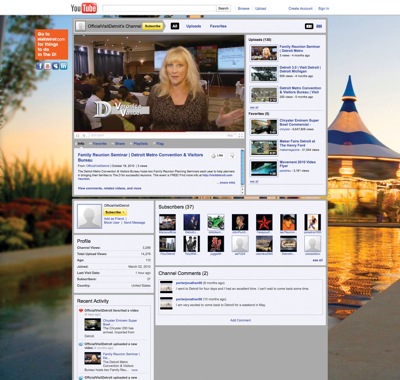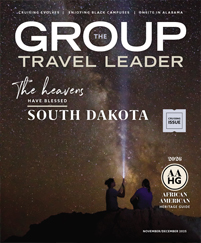
Visit Detroit’s tourism website
Five years ago, most destination marketers hadn’t heard of YouTube, an upstart online video service that launched in late 2005. Today, hundreds of convention and visitors bureaus around the country use the free online service as a way to publicize their destinations to the growing ranks of tech-savvy travelers.
In the short time since they were launched, YouTube, Facebook and other social networking services have created a new era in destination marketing.
Although social networking applications have not replaced traditional print, broadcast and other media, they give destination marketers new avenues for interacting directly with their customers and spreading travel news to their friends and followers around the world.
Social media has also created new methods for group leaders to work with CVBs, offering unprecedented access to trip ideas, destination news, promotional materials and person-to-person connections.
Video on the go
The Syracuse Convention and Visitors Bureau in New York has taken advantage of YouTube to help followers around the country see aspects of the city as locals see it.
“We got started with YouTube about a year and a half or so ago with a general overview video,” said Danielle Rauch, the CVB’s online promotions manager. “Last year, I had the idea to get a little Flip camera and have been taking it out to different events and making two- to three-minute videos to highlights some of the things going on here.”
Rauch says that the homemade feel of the videos adds an air of authenticity to them, making them more interesting and more believable than those that feel like commercials. The CVB has posted about 35 of these videos on its YouTube channel and has added another 75 videos that were uploaded independently by locals and visitors to Syracuse.
“People don’t want to hear just from the CVB or the hotel manager,” Rauch said. “They want to hear from people who have actually experienced the area and to see other visitors’ recommendations.”
Redefining its image
Facing economic slowdowns and a steady stream of negative press, the Detroit Metro Convention and Visitors Bureau uses YouTube to spread the word about brand attributes such as cars, music and gaming to younger travelers.
“We decided that if we could shoot a lot of two- to three-minute videos on those topics and post them online, we would be creating an ongoing presence that shows a lot of aspects of Detroit that the average visitor wasn’t aware of,” said vice president of sales and marketing Chris Baum.
The CVB hired a production company to visit Detroit restaurants, museums and events, creating several hundred video documentaries that emphasize the city’s strengths.
Baum said that the CVB has also done custom videos for tour operators and that group leaders can use the video library to help create buzz about a trip to Detroit.
“A high percentage of folks have never been here before, so some folks find it helpful for us to send them links we have to videos of their areas of interest,” he said. “Because we have such a deep list of subjects, chances are we have something to show them that people will like.”
Immediate response
When the Deepwater Horizon oil spill created a tourism panic in the Gulf of Mexico last year, the Mississippi Gulf Coast Convention and Visitors Bureau began posting videos on YouTube to show visitors that its beaches were still open. Since then, immediate response has become a hallmark of the bureau’s social presence.
“I’m on it constantly. If you have a question, I can respond to it within an hour,” said the CVB’s social media specialist, Taryn Sammons. “It’s a way for people to ask questions, and you get almost an immediate response. It’s creating a new method of communication.”
Since social media is a large portion of her job duties, Sammons spends a lot of time on Twitter and Facebook. She tries to send a tweet every two to three hours, and usually posts something on Facebook two or three times a day.
The content often helps expose visitors to attractions beyond the beach.
“We use it to show people what else they can do here,” Sammons said. “Most of your YouTube videos feature group-friendly museums and restaurants. Facebook I use to market events that are coming, like a rolling calendar.”
Extending relationships
At the Beaumont Convention and Visitors Bureau in Texas, Facebook and Twitter have helped the staff extend professional relationships.
“When you go to a convention, you meet all these people,” said communications manager Ashley White. “While they may be great contacts and you get good info while you’re there, sometimes that’s the end of it. But Twitter and Facebook really give you the opportunity to build on that relationship.”
CVB staffers often form online relationships with the group leaders, meeting planners and journalists they meet at professional events, and then use Twitter feeds and Facebook posts to provide regular doses of information about Beaumont and keep potential visitors engaged in conversation.
Although it can be difficult to track return on investment, White says the increased awareness of the destination is always welcome.
“We’re not Austin or San Antonio, but now people are saying that they know Beaumont,” she said. “So even if it’s just bringing the word ‘Beaumont’ to the top of their minds, that’s helpful.”
www.beaumontcvb.com
Tracking perceptions
The Rockford Area Convention and Visitors Bureau in Illinois has found that its 1,800 Twitter followers and 900 Facebook fans help it keep tabs on perceptions of its destination.
“Facebook has been very successful for us,” said Monica Krysztopa, vice president of sales and marketing. “We use it as a monitoring tool to see what perceptions about Rockford are and how people’s experiences have been while they’re here.”
Krysztopa said she has been surprised that many CVBs’ Facebook fans ask to be added to the organization’s e-mail list for newsletters. Facebook and Twitter followers also use the channels to ask questions about visiting Rockford or to find information quickly.
Because the CVB also has a fair number of locals in its social networks, staffers also use those tools to help publicize upcoming group tours in Rockford.
“It’s a great way to create excitement or anticipation about a group coming to our community,” Krysztopa said. “It makes our city aware of who’s coming to town, and they can become a part of establishing that relationship.”
Social blitz
Since 2009, the Greater Phoenix Convention and Visitors Bureau has leveled something of a social blitz, using Facebook, Twitter, YouTube, Flickr and a blog to reach potential visitors.
Among the bureau’s innovative ideas was a series of “dream day” videos that feature local celebrities walking viewers through their ideal day exploring Phoenix attractions. CVB staffers blog from area events and attractions, and then post photos they’ve taken on their outings to the Flickr site.
The organization has also found a way to tie all of its social streams together, building a page on its website called “The Social Club” that pulls in feeds from all of its social networks and consolidates them in one space for visitors. The page is becoming one of the most visited parts of the CVB website.
“Social media isn’t going away anytime soon, and it’s sort of the fun side of marketing,” said director of marketing Melissa Gogel. “You can interact with real people who are coming here and realize that there’s a face behind that. It’s easier to have a conversation with them, and that’s something you can’t really do through traditional media.”










